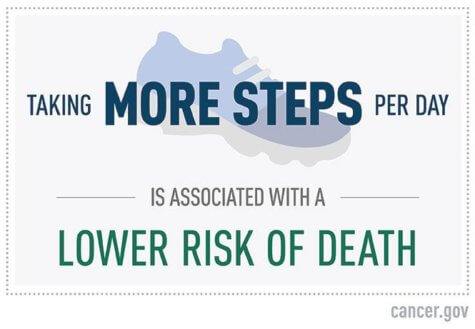BETHESDA, Md. — Get up and start walking. The more you do it, the longer you may live. That’s the main piece of advice from a new study that found a higher daily step count is associated with a lower mortality risk from all causes. Who needs the couch anyway?
Even better, the study also noted that it’s not about intensity; you don’t have to run or even jog all day to enjoy a longer life. Just put one foot in front of the other.
 The study was conducted by researchers from the National Cancer Institute, National Institute on Aging, and Centers for Disease Control and Prevention.
The study was conducted by researchers from the National Cancer Institute, National Institute on Aging, and Centers for Disease Control and Prevention.
“While we knew physical activity is good for you, we didn’t know how many steps per day you need to take to lower your mortality risk or whether stepping at a higher intensity makes a difference,” says Pedro Saint-Maurice, Ph.D., of NCI’s Division of Cancer Epidemiology and Genetics, first author of the study, in a release. “We wanted to investigate this question to provide new insights that could help people better understand the health implications of the step counts they get from fitness trackers and phone apps.”
There have been other studies performed in the past on walking and lifespan, but those projects focused heavily on the elderly and people with chronic medical conditions. This study, however, examined a sample of roughly 4,800 U.S. adults aged 40 and over who wore tracking devices for up to seven days between 2003-2006. After that, each person’s lifespan was tracked up until 2015 using the National Death Index.
After accounting for a range of potentially contributing demographic and behavioral factors, they found a significant connection between steps taken daily and mortality risk.
Generally speaking, 4,000 steps per day is thought to be low for adults. Participants who walked 8,000 steps per day had a 51% lower risk of dying from any cause than those who only walked 4,000 steps per day. Moreover, 12,000 steps per day was linked to a 65% lower mortality risk than 4,000 daily steps. Again, there was no connection found between step intensity and mortality risk.
“At NIA, we’ve long studied how exercise is important for older adults, and it’s good to see further evidence from a large study with a broad sample that the main thing is to get moving for better overall health as we age,” says Eric Shiroma, Ph.D., a study co-author and NIA Intramural Research Program scientist.
These findings were universal across age groups, genders, and races (Caucasian, African-American, Mexian-American).
All in all, the research team say any amount of physical movement is better than none for older adults. Ideally, everyone should aim to achieve roughly 150 minutes of moderate-to-intense exercise per week.
“Being physically active has many benefits, including reducing a person’s risk of obesity, heart disease, type 2 diabetes, and some cancers. And on a daily basis, it can help people feel better and sleep better,” concludes Janet Fulton, Ph.D., of CDC’s Division of Nutrition, Physical Activity, and Obesity. “CDC is working with communities and partners across the country, as part of the Active People, Healthy Nation initiative, to make it easier, safer, and more convenient for people to be active in their own communities.”
The study is published in JAMA.
